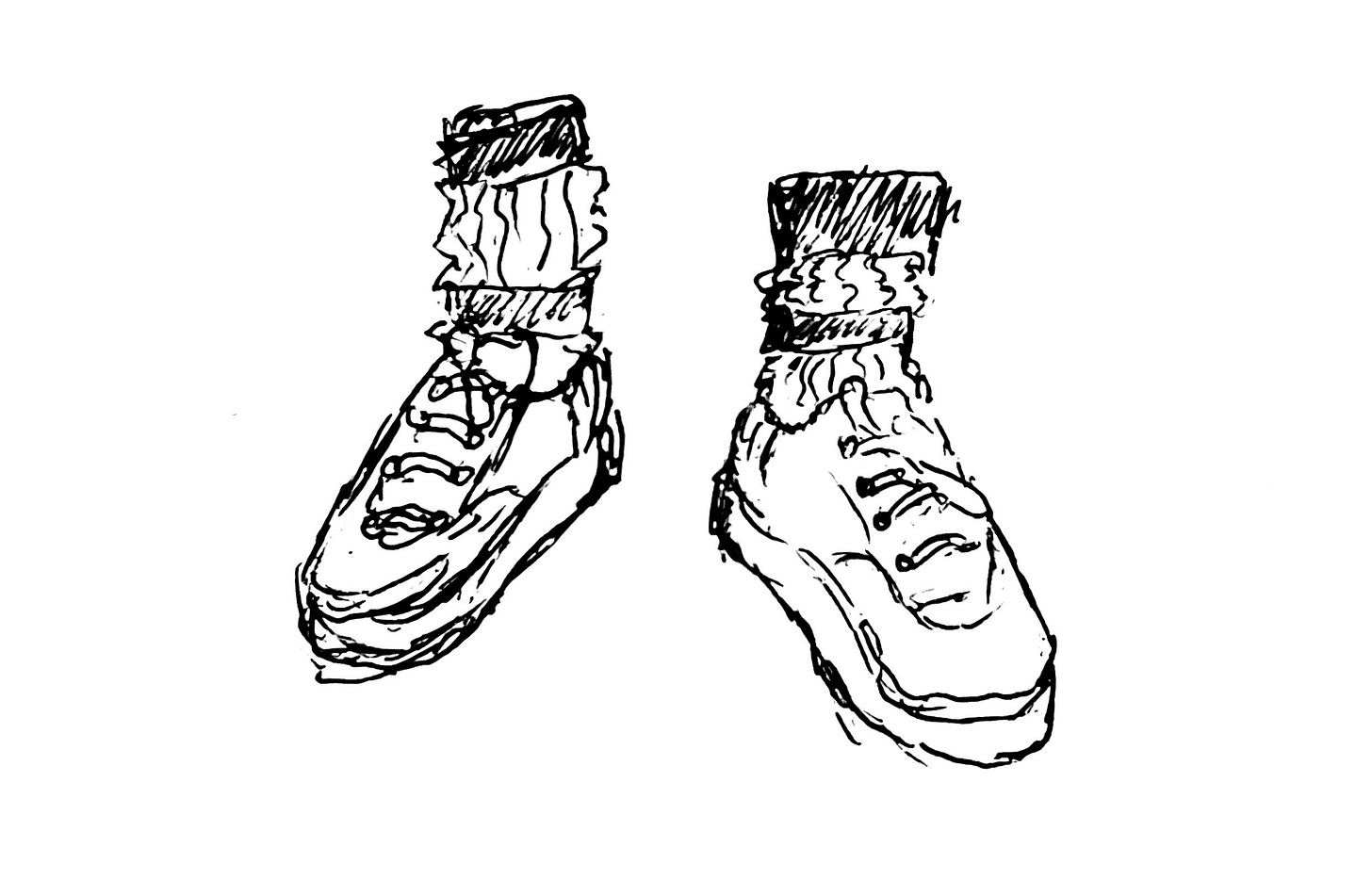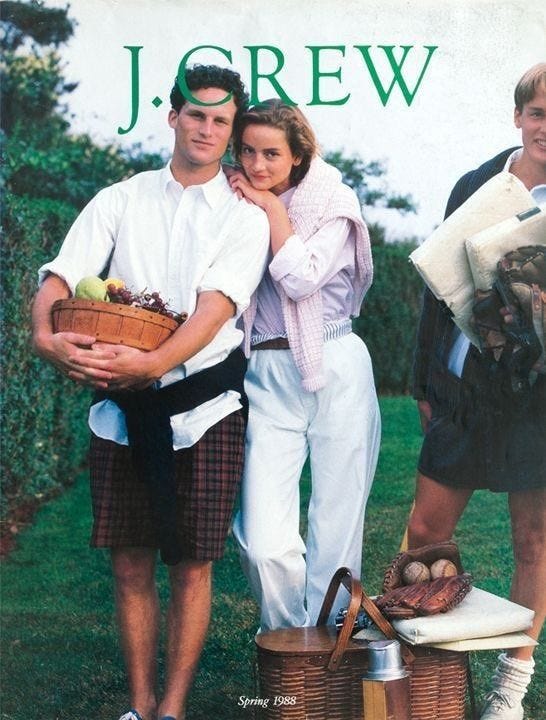Heads up: at first this reads a bit like an essay (I’m aware that’s my fault), IT IS NOT, It’s an opinion piece and nothing more. There is a lot of scope to explore these ideas in a more academic approach to philosophy, it’s just not the sort of thing I do here.
If we burrow down to the root of most value judgements made in relation to the arts, music/ fashion/ food/ whatever, we tend to arrive at some sort of discussion of authenticity. Perhaps even a positing of it as a fundamental, that which a given artefact must possess in order to be considered proper, to be considered real and therefore good.
In fashion, we see authenticity first at a material level, I’ve heard the term “honest materials” thrown about as of late to mean materials which do not hide what they are, if they are synthetic they appear to be synthetic, take shiny nylon ripstop as opposed to acrylic knitwear. Then we have authenticity at the brand level, products which are genuinely of a particular manufacturer, self-explanatory. Then we have authenticity at the styling level where things get a little muddier. We’re no longer dealing with an authenticity with a fundamental truth but rather an authenticity which relates to identity. If you’d care to make your way to the hat-rack, we’re wearing our thinking caps today.
Welcome to The Prep Club, last week I launched THE RADAR, the spiritual successor to the Club Chair Bulletin, still the same scrapbook recommendations as before but in a more concise format. Take a look here or on your way out. Also, please make use of The Directory, an alphabetised list of stores and labels specialising in collegiate fashion. New additions this week:
Auter - Manchester, E-Comm - Militaria and workwear specialists, stocking Buzz Rickson and Pherrow’s among others. Great for more retro looks.
Keaton Chase - Japanese shirt-makers making modern day recreations of Ivy classics. Great for popovers and a perfectly curated selection of tartans. Sizing up is a necessity.
D.C. White - Japanese Ivy reproduction specialists. Excellent for Madras shirting and soft shouldered tailoring.
Small Favour: If you wouldn’t mind, please share this post, or the club as a whole, with a friend who you think might be interested, it would mean a whole lot. Please also subscribe if you haven’t yet, again, it makes a big difference.
Authenticity of Identity
With a more ephemeral subject matter, we need to explore a more plastic concept of authenticity, one that doesn’t rely on a fundamental truth to which a given artefact’s authenticity can be compared. (yep we’re using the term “artefact” today)
I’m not overly interested in diving deep into the philosophy of identity, there are plenty of far better educated writers who have explored this in far more depth. My general understanding of identity is as a process of becoming, it is dynamic, and a communication both inwards and outwards. It is in this dynamism that trying to ascribe a concrete sense of authenticity to someone’s identity first stumbles.
There are certain unassailable, cultural boundaries which exist in fashion, traditional forms of dress which should only be worn by those with a justifying connection to the culture with which those forms of dress belong. Ignoring those who elect for some bizarre reason to overstep those boundaries, it is very difficult to accurately describe an outfit someone is wearing as authentic or inauthentic. The core-ification of fashion has resulted in an element of cosplay in outfits across the zeitgeist, a greater sense of performance in the approach to outfits. BoF identify that Generation Z, regarding their reputation as trend obsessives, tend to buy into many trends at a more shallow level, than follow any one trend wholesale. This has greater implications for personal style which Mina Le deftly explores here. Also, with core-ification there is the consideration that many of these trends don’t have a pedigree which one could be authentic too, they exist as single moments.
This is all to say that, attempting to describe an outfit worn by somebody in twenty-twenty-five as concretely authentic or inauthentic to their identity in most cases will fail because that individual’s identity is not concrete, and also because there is no clear idea of what an authentic engagement with a given style even looks like. Rather, when considering the authenticity of someone’s dress, it is more useful to explore an authenticity of taste.
Authenticity of Taste
The question becomes whether our desire to dress in a certain way is authentic. Does it come from a place of genuine interest, research, and/or aesthetic enjoyment as opposed to a desire to follow a trend, conform to an expectation.
In essence, you have to like the clothes you put on, you have to like how they look together, you have to have put them together because YOU like them together. Failing to do so is the source of that uncanny valley feeling you get from seeing celebrities in outfits that their stylist has clearly put them in against their will.
Take the bank swag brigade, I tend back to this example regularly but that’s because it’s a good one. This applies to pretty much any era on Wall Street, but I’ll use the most current. No-one wears a Patagonia vest and a poplin shirt unbuttoned because they actually, genuinely love how it looks, love the history of Patagonia and their environmental work, love the way slim fit poplin feels in their too-high arm holes. They wear it because that is the done thing. This is inauthentic.
On the other hand, take the guy in a comic book hoodie, who wears it because they’ve read those stories for years, because they mean something to them, that is authentic taste. Likewise, it might be someone’s authentic desire not to think about their dress at all, to stick on a tracksuit and call it a day. At this point it’s important to understand that an outfit can be authentic to the wearer and still aesthetically upsetting to others. Not liking something is never grounds alone for a claim of inauthenticity.
The Preppy Problematic
To explore authenticity in prep, we first need to decide whether it is a form of dress that belongs exclusively to a specific culture. It is not. Principally it is not because of power, this sort of collegiate attire was at one point the dress of a social group but that group was the white elite, if I need to explain to you why those in positions of power cannot be victims of oppression from those over whom they have power, then you’ve got more important reading to do than this article about clothes.
It is also not because that which was once ivy and prep is now far too diffuse in Western dress. Business casual is, in essence, the bastard offspring of ivy’s informal approach to tailoring. Almost all features of the collegiate canon have found homes elsewhere in Western attire.
Further, there is far more weight put on an idea of collegiate fashion than how it was actually practiced. Since the seventies, Ralph Lauren, J. Crew, and other contemporaries built prep up as a marketing powerhouse, co-opting the aspirational nature of the life of opulence lived by the moneyed and privately educated. This is a vision, not a culture. It is in this idealised prep that we also encounter our issues of authenticity. In trying to apply an authenticity of identity we realise there is no identity to be authentic to, we never wanted to dress like WASPs we wanted to dress like JFK and Miles Davis, guys who had impeccable, authentic taste. In trying to define authenticity in prep we end up with elitism and racism, unless we define it using an authenticity of taste as the yardstick.
In the twenty-first century, collegiate fashion authenticity isn’t about whether you genuinely went to an Ivy league or a prep school. It’s not about going to Nantucket or letting people know you go to Nantucket. It’s not about being a yuppie or a preppy, in fact if I catch you self describing with either of those terms you’re staying behind after class. It’s about putting that shit on as the folks over at Spyplane might say, you need to LIKE THE SHIT YOU WEAR on a fundamental level, and you need to communicate to others (through your outfits) that you like it. Authenticity is ascribed, not inscribed, don’t forget that.
Prep club adjourned, see you next time.
Black and White, Barbour, and Skating Mocs
Hello! Welcome to The Radar, the partial, spiritual successor to Club Chair Bulletin. Much the same as before, scrapbook style updates on the world of collegiate fashion and anything that happens to be bouncing around on the inside of my head, just a simplified format. Also a move towards including some exclusive content for paid subscribers, the club’s Friday meetings will always be free to attend.












